#3d clothing design software free
Text
youtube
#Clo#CLO 3D#CLO 3D Software#Fashion design software#3D Dress design#Clothing Design Software#3D Cloth#Cloth 3D Model#3D Designer#3d clothing design software free#3d clo#competitive exam#digital marketing course#fashion designing course#NIFT#NID#Uceed#NATA#Youtube
2 notes
·
View notes
Photo

Decided to post the whole thing on Tumblr, since Tumblr is just perfect for longreads.
Here is a small background tutorial I did a few days ago! Hope you guys enjoy it!
I decided to make this tutorial free, but if you wish to leave a small tip you can do it at my BMC page. But basically all I wish for is to share this thing with others, so I would really appreciate some reblogs here!
This tutorial is not for the beginners, it requires some basic knowledge on perspective drawing (but don’t worry, I got you covered: here’s my easy guide to perspective drawing). 3D-modelling skills aren’t necessary though, there are plenty of free models out there that can be used in personal or even commercial projects.
All the architecture and interior element designs/3D models are my own (I use SketchUp for modeling), the pillows and cloth are some random 3D-models used as a base with a bit of overpainting. The background is photobashing (I always use the assets published under Creative Commons license or similar licenses, especially now when I can't buy stock images and packs for photobashing) with some paintover. The nice brushes I used to draw leaves are from LoranDeSore pack (you can find it on her DeviantArt page) and the watercolor texture I used on top of the image are made by Hibbary (check out their DA for texture packs).
There are plenty of nice free assets out there, both for Photoshop and CSP, and I think it is important to share this stuff with others, especially knowing that not everyone can afford paying for brushes, textures and stocks. And if you can't afford PS or CSP either there are a lot of software developers who offer their stuff for free, everyone can download Krita and Gimp or other amazing stuff online.
I find it funny when Ai-bros say that artists are gatekeeping (all while fighting with each other over prompts). Like, it literally have never been easier to find tutorials, assets and instruments for your creations.
295 notes
·
View notes
Text
「viRtua canm0m」 Project :: 002 - driving a vtuber
That about wraps up my series on the technical details on uploading my brain. Get a good clean scan and you won't need to do much work. As for the rest, well, you know, everyone's been talking about uploads since the MMAcevedo experiment, but honestly so much is still a black box right now it's hard to say anything definitive. Nobody wants to hear more upload qualia discourse, do they?
On the other hand, vtubing is a lot easier to get to grips with! And more importantly, actually real. So let's talk details!
Vtubing is, at the most abstract level, a kind of puppetry using video tracking software and livestreaming. Alternatively, you could compare it to realtime mocap animation. Someone at Polygon did a surprisingly decent overview of the scene if you're unfamiliar.
Generally speaking: you need a model, and you need tracking of some sort, and a program that takes the tracking data and applies it to a skeleton to render a skinned mesh in real time.
Remarkably, there are a lot of quite high-quality vtubing tools available as open source. And I'm lucky enough to know a vtuber who is very generous in pointing me in the right direction (shoutout to Yuri Heart, she's about to embark on something very special for her end of year streams so I highly encourage you to tune in tonight!).
For anime-style vtubing, there are two main types, termed '2D' and 3D'. 2D vtubing involves taking a static illustration and cutting it up to pieces which can be animated through warping and replacement - the results can look pretty '3D', but they're not using 3D graphics techniques, it's closer to the kind of cutout animation used in gacha games. The main tool used is Live2D, which is proprietary with a limited free version. Other alternatives with free/paid models include PrPrLive and VTube studio. FaceRig (no longer available) and Animaze (proprietary) also support Live2D models. I have a very cute 2D vtuber avatar created by @xrafstar for use in PrPrLive, and I definitely want to include some aspects of her design in the new 3D character I'm working on.

For 3D anime-style vtubing, the most commonly used software is probably VSeeFace, which is built on Unity and renders the VRM format. VRM is an open standard that extends the GLTF file format for 3D models, adding support for a cel shading material and defining a specific skeleton format.
It's incredibly easy to get a pretty decent looking VRM model using the software VRoid Studio, essentially a videogame character creator whose anime-styled models can be customised using lots of sliders, hair pieces, etc., which appears to be owned by Pixiv. The program includes basic texture-painting tools, and the facility to load in new models, but ultimately the way to go for a more custom model is to use the VRM import/export plugin in Blender.
But first, let's have a look at the software which will display our model.
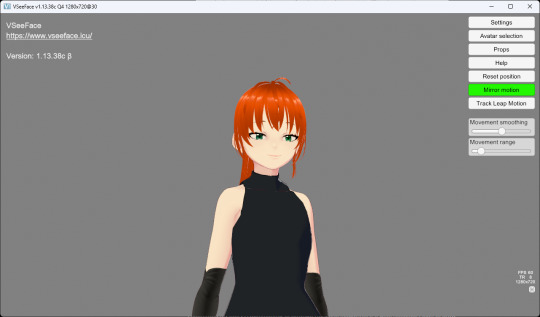
meet viRtua canm0m v0.0.5, a very basic design. her clothes don't match very well at all.
VSeeFace offers a decent set of parameters and honestly got quite nice tracking out of the box. You can also receive face tracking data from the ARKit protocol from a connected iPhone, get hand tracking data from a Leap Motion, or disable its internal tracking and pipe in another application using the VMC protocol.
If you want more control, another Unity-based program called VNyan offers more fine-grained adjustment, as well as a kind of node-graph based programming system for doing things like spawning physics objects or modifying the model when triggered by Twitch etc. They've also implemented experimental hand tracking for webcams, although it doesn't work very well so far. This pointing shot took forever to get:
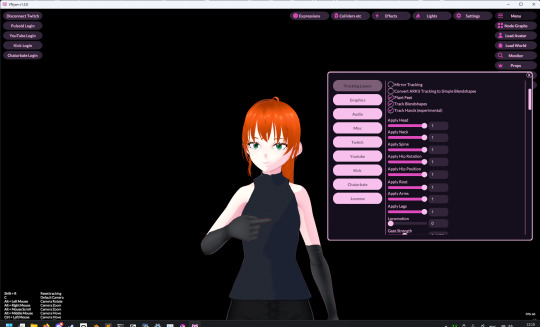
<kayfabe>Obviously I'll be hooking it up to use the output of the simulated brain upload rather than a webcam.</kayfabe>
To get good hand tracking you basically need some kit - most likely a Leap Motion (1 or 2), which costs about £120 new. It's essentially a small pair of IR cameras designed to measure depth, which can be placed on a necklace, on your desk or on your monitor. I assume from there they use some kind of neural network to estimate your hand positions. I got to have a go on one of these recently and the tracking was generally very clean - better than what the Quest 2/3 can do. So I'm planning to get one of those, more on that when I have one.
Essentially, the tracker feeds a bunch of floating point numbers in to the display software at every tick, and the display software is responsible for blending all these different influences and applying it to the skinned mesh. For example, a parameter might be something like eyeLookInLeft. VNyan uses the Apple ARKit parameters internally, and you can see the full list of ARKit blendshapes here.
To apply tracking data, the software needs a model whose rig it can understand. This is defined in the VRM spec, which tells you exactly which bones must be present in the rig and how they should be oriented in a T-pose. The skeleton is generally speaking pretty simple: you have shoulder bones but no roll bones in the arm; individual finger joint bones; 2-3 chest bones; no separate toes; 5 head bones (including neck). Except for the hands, it's on the low end of game rig complexity.
Expressions are handled using GLTF morph targets, also known as blend shapes or (in Blender) shape keys. Each one essentially a set of displacement values for the mesh vertices. The spec defines five default expressions (happy, angry, sad, relaxed, surprised), five vowel mouth shapes for lip sync, blinks, and shapes for pointing the eyes in different directions (if you wanna do it this way rather than with bones). You can also define custom expressions.
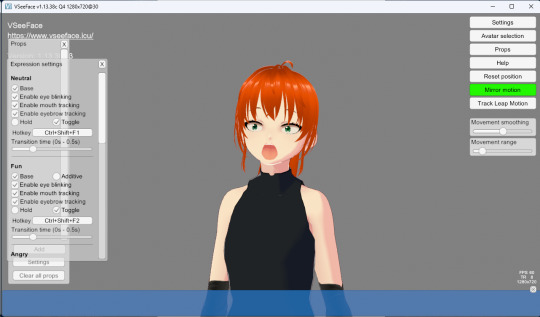
This viRtua canm0m's teeth are clipping through her jaw...
By default, the face-tracking generally tries to estimate whether you qualify as meeting one of these expressions. For example, if I open my mouth wide it triggers the 'surprised' expression where the character opens her mouth super wide and her pupils get tiny.
You can calibrate the expressions that trigger this effect in VSeeFace by pulling funny faces at the computer to demonstrate each expression (it's kinda black-box); in VNyan, you can set it to trigger the expressions based on certain combinations of ARKit inputs.
For more complex expressions in VNyan, you need to sculpt blendshapes for the various ARKit blendshapes. These are not generated by default in VRoid Studio so that will be a bit of work.
You can apply various kinds of post-processing to the tracking data, e.g. adjusting blending weights based on input values or applying moving-average smoothing (though this noticeably increases the lag between your movements and the model), restricting the model's range of movement in various ways, applying IK to plant the feet, and similar.
On top of the skeleton bones, you can add any number of 'spring bones' which are given a physics simulation. These are used to, for example, have hair swing naturally when you move, or, yes, make your boobs jiggle. Spring bones give you a natural overshoot and settle, and they're going to be quite important to creating a model that feels alive, I think.
Next up we are gonna crack open the VRoid Studio model in Blender and look into its topology, weight painting, and shaders. GLTF defines standard PBR metallicity-roughness-normals shaders in its spec, but leaves the actual shader up to the application. VRM adds a custom toon shader, which blends between two colour maps based on the Lambertian shading, and this is going to be quite interesting to take apart.
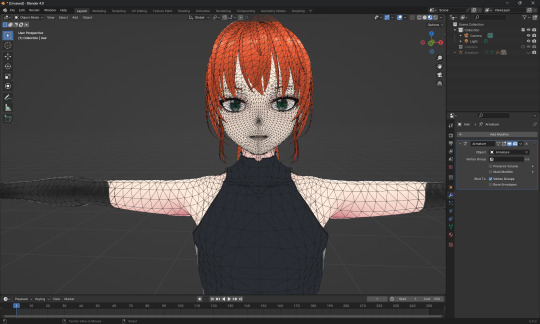
The MToon shader is pretty solid, but ultimately I think I want to create custom shaders for my character. Shaders are something I specialise in at work, and I think it would be a great way to give her more of a unique identity. This will mean going beyond the VRM format, and I'll be looking into using the VNyan SDK to build on top of that.
More soon, watch this space!
9 notes
·
View notes
Note
Hello! I am amazed by your work, and I am very curious as to what software you use to make new clothes? Blender ? Marvelous Designer? Are you stripping the 3D characters first and then adding new clothing?
Thank you :)
hello !
I use blender exlusively, i did try Marvelous designer but couldn't get into it before the end of the free trial lmao
if you want to make new clothes for the characters the easiest way to do it is to use clothes from the game as base and edit them ( saves you a lot time since the heavy work is already done , i have a tutorial showing how i do an outfit edit for Yennefer using only game assets ->
youtube
then once you feel more comfortable adding bits and pieces made from scratch never hurts ;)
not sure what you mean but to add new clothes i just replaced the vanilla outfit meshes with the new modded ones, simple as that
8 notes
·
View notes
Text
This is the product of a four-year endeavor to see if I can actually make a 3D animated film using only free/open source software, on a laptop(mostly), by myself.
This is an experimental film that I started to see whether or not I can make a 3D animated film. With characters and environment that I designed, modeled and prepared for animation. Also doing the animations myself, especially with characters interacting with each other. How to handle the physics simulations(hair, cloth, etc.) Lighting, Rendering, Compositing and Editing. Adding sound and music just telling a story through 3D animation.
This is also a fan adaptation of a portion of the book, Gregor the Overlander by Suzanne Collins. I decided to do this experiment using an existing story because I don't really want to risk my own original stuff for it. 😅 So I took a big risk on this one without risking too much. At the same time bringing to life a story that I love! The mission was to know how to take a story from script into a finished 3D animated film. Figure out the technical stuff and also enduring the labor of a 3D animation production. And I believe I fulfilled that mission. I learned A LOT with this one and I can honestly say that if I were to do this again with the amount of knowledge I have now, I could do it in half the time. And yep, there's definitely still room to grow! I've shared everything about this film, since I started its creation through a series of videos here: https://youtube.com/playlist?list=PL6knnwMF9fRd4HMVp8I1n-v9oxFMOSpXW
This is a fan 3D animated film based on some events from the book Gregor the Overlander by Suzanne Collins. Doodle Notes Production is not affiliated with Suzanne Collins or other licensor/owners of the book.
A product of #TheUnderlandProject
Thanks to these KoFi giving folks!
Mbuddy
GulliermoGage
Handsomeness Jubin
Tristan Wintle
Elizabeth Munie
Erick Madrigal
Magnolia Weathershield
yaejinssi
Ja-Ne
Fritzzzzzzz
Support me on KoFi!
https://ko-fi.com/doodlenotesproductions
Enter the World to Awesomeness on Discord!
https://discord.gg/rKGgnAa
SUBSCRIBE to see more awesomeness!
http://youtube.com/c/DoodleNotes?sub_confirmation=1
Wanna know how we make awesome videos?
Check out our 2ND CHANNEL here:
https://www.youtube.com/c/DoodleNotesII
FACEBOOK: https://www.facebook.com/DoodleNotes
TWITTER: https://twitter.com/DoodleNotes
INSTAGRAM: https://www.instagram.com/doodlenotesproductions
TUMBLR: https://doodlenotesproductions.tumblr.com/
This film is made with the following FREE/OPEN SOURCE software!
http://bit.ly/DoodleNotesProductionsArsenal
#GregorTheOverlander#BlenderAnimation#Blender3D#FanAnimatedFilm#the underland project#the underland chronicles#gregor the overlander#journey to awesomeness#blender 3d#blender animation#3d animation#animation#journeytoawesomeness
113 notes
·
View notes
Text
Apple Vision Pro: Revolutionizing Augmented Reality
Apple, a trailblazer in technology innovation, has unveiled its latest breakthrough in augmented reality (AR) with the Apple Vision Pro. This cutting-edge device promises to redefine the way we interact with digital content, bridging the gap between the virtual and real worlds. In this article, we'll explore the features and potential impact of the Apple Vision Pro on the AR landscape.
The Birth of Apple Vision Pro
Apple's vision for AR technology has been taking shape over the years, with the release of ARKit, ARCore, and the AR-focused LIDAR scanners in their devices. The Apple Vision Pro represents the culmination of these efforts, combining hardware and software to create a powerful AR experience.
Hardware Innovation
At the heart of the Apple Vision Pro is its impressive hardware lineup. The device boasts a sleek, lightweight headset with a wide field of view, ensuring an immersive AR experience. The headset is equipped with advanced sensors and cameras for precise tracking, gesture recognition, and spatial mapping, allowing users to interact seamlessly with virtual objects in their real environment.
Display Technology
The Apple Vision Pro features state-of-the-art display technology that provides stunning visuals. The high-resolution OLED displays offer vibrant colors and deep blacks, ensuring that virtual objects blend seamlessly with the real world. Apple's commitment to display quality ensures a comfortable and immersive AR experience for users.
Spatial Audio
To enhance immersion, Apple Vision Pro includes spatial audio technology. This allows users to hear virtual sounds as if they were coming from their physical surroundings, creating a more convincing and engaging AR experience. Whether it's directional cues or ambient sounds, the audio adapts to the user's perspective, further blurring the lines between the real and virtual worlds.
Performance
Under the hood, the Apple Vision Pro is powered by a custom-designed Apple Silicon chip, specifically optimized for AR applications. This ensures smooth performance, low latency, and efficient power consumption. Users can expect high-quality AR experiences without compromising on battery life.
Software Ecosystem
Apple has a robust software ecosystem that integrates seamlessly with the Apple Vision Pro. The device is fully compatible with the App Store, meaning users can access a wide range of AR apps and experiences. Developers are also given the tools and resources to create innovative AR applications, opening up new possibilities for entertainment, education, and productivity.
Applications and Use Cases
The Apple Vision Pro has the potential to revolutionize numerous industries and domains:
Gaming: Immersive AR gaming experiences will take center stage, with users physically interacting with virtual environments and characters.
Education: Augmented reality can enhance learning by providing interactive and immersive educational content, making complex subjects more engaging.
Medical: Surgeons can use AR for real-time guidance during complex surgeries, and medical students can practice procedures in a risk-free virtual environment.
Architecture and Design: Architects and designers can visualize and manipulate 3D models of buildings and products in real-world settings.
Entertainment: AR concerts, theater performances, and art installations will become more interactive and engaging.
Retail: Customers can try on virtual clothing and accessories, enhancing the online shopping experience.
Conclusion
The Apple Vision Pro represents a significant leap forward in the world of augmented reality. With its cutting-edge hardware, immersive display technology, spatial audio, and powerful software ecosystem, it has the potential to transform how we interact with digital content in our everyday lives. As Apple continues to refine and expand the capabilities of the Apple Vision Pro, we can anticipate a future where augmented reality seamlessly integrates into our reality, opening up new horizons for innovation and creativity.
2 notes
·
View notes
Text
How Technology is Shaping the Future of Fashion Design
In the dynamic world of fashion, technology has emerged as a formidable force, completely transforming the way designers conceive, fabricate, and exhibit their collections. From groundbreaking materials to state-of-the-art production techniques, technology is revolutionizing every facet of the fashion realm. One of the most notable impacts of technology on fashion design lies in the realm of sustainability. As environmental concerns continue to escalate, designers are harnessing technology to develop eco-friendly alternatives to conventional materials and processes. For instance, advancements in biotechnology have paved the way for the creation of lab-grown fabrics like lab-made leather and silk, offering a sustainable and cruelty-free substitute to their animal-derived counterparts.
Likewise, 3D printing technology empowers designers to craft intricate garments with minimal waste, effectively reducing the industry's carbon footprint. Furthermore, technology is democratizing the design process, making it more accessible to aspiring designers and enthusiasts alike. With the advent of Computer-Aided Design (CAD) software, individuals armed with a computer and an internet connection can now experiment with digital design tools to bring their imaginative visions to fruition. Online platforms and marketplaces further facilitate independent designers in showcasing and selling their creations to a global audience, circumventing the traditional gatekeepers of the industry.
The democratization of design not only encourages creativity and innovation but also fosters diversity and inclusivity within the fashion community. Another area where fashion design is being revolutionized by technology is in the realm of personalization and customization. With the emergence of AI (Artificial Intelligence) and machine learning algorithms, brands can analyze vast amounts of data to gain insights into consumer preferences and tailor their offerings accordingly. This data-driven approach empowers designers to create personalized shopping experiences, where customers have the ability to customize everything from the fit and style of their garments to the fabric and color choices.
The ability to customize not only enhances customer satisfaction but also reduces waste by producing garments on demand, thereby minimizing excess inventory. Moreover, technology is blurring the boundaries between the physical and digital worlds, giving rise to new forms of expression and interaction. Fashion brands are utilizing Augmented Reality (AR) and Virtual Reality (VR) technologies to create immersive experiences, enabling customers to virtually try on garments and visualize how they would look in real life. Virtual fashion shows and digital fashion collections are also gaining popularity, providing designers with an innovative and engaging platform to showcase their work. These digital advancements not only expand the possibilities for creative expression but also have the potential to redefine the traditional fashion calendar and transform the way we consume fashion media.
Technology is certainly revolutionizing the future of fashion design in significant and thrilling ways. With the use of sustainable materials and digital design tools, along with personalized shopping experiences and immersive virtual realities, technology is leading the charge in innovation and revolutionizing all facets of the fashion sector. As designers increasingly adopt and utilize the capabilities of technology, we anticipate witnessing further pioneering advancements that will influence our clothing choices and self-expression for the foreseeable future. Embracing technology goes beyond mere relevance; it involves redefining the core of fashion in the era of digitalization. The future of fashion design goes beyond creating beautiful garments; it involves crafting a compelling narrative that resonates with the global community and has a positive impact on individuals and the environment. Dream Zone is a distinguished institution that offers one of the top fashion design courses in the industry. Known for its unwavering commitment to excellence, Dream Zone provides a comprehensive curriculum that equips aspiring designers with the necessary skills and knowledge for a successful career in the ever-changing world of fashion. The course is specifically designed to nurture creativity, foster innovation, and develop a profound understanding of the evolving trends in the fashion industry.
0 notes
Text
3D Animation Course in Delhi.
https://picklesanimation.in/3d-animation-courses/
Here's a structured course content outline for a 3D animation course offered by Pickles Animation:
Title: 3D Animation Course by Pickles Animation
Course Overview: This comprehensive course is designed to provide participants with the knowledge and skills required to create professional-quality 3D animations. From understanding 3D animation principles and character rigging to mastering animation software and rendering techniques, students will gain practical experience through hands-on projects and real-world case studies.
Course Content:
Introduction to 3D Animation
Understanding the basics of 3D animation
Overview of animation principles in the context of 3D
Introduction to 3D animation software and tools (e.g., Autodesk Maya, Blender)
Modeling
Basics of 3D modeling techniques (polygonal, NURBS, sculpting)
Creating and manipulating 3D objects and shapes
Understanding topology and edge flow for efficient modeling
Texturing and Shading
Basics of texturing and shading in 3D animation
Applying materials and textures to 3D models
Understanding UV mapping and texture painting
Rigging and Character Animation
Basics of character rigging for animation
Creating skeletons and rig controls
Animating characters using rigging tools and techniques
Animation Principles in 3D
Applying animation principles (squash and stretch, timing, anticipation) in 3D animation
Understanding keyframe animation and interpolation
Creating believable character movements and performances
Lighting and Rendering
Basics of lighting techniques in 3D animation
Setting up lights and shadows for scenes
Rendering animations using software renderers and third-party render engines (e.g., Arnold, V-Ray)
Particle and Dynamics
Introduction to particle effects and dynamics simulations
Creating realistic physics-based animations (e.g., cloth, hair, fluids)
Integrating dynamics simulations into 3D scenes
Camera and Cinematography
Basics of camera setup and composition in 3D animation
Creating dynamic camera movements and shots
Understanding cinematography principles for storytelling in 3D animation
Special Effects and Compositing
Adding visual effects and post-processing to animations
Compositing 3D elements with live-action footage
Enhancing animations with effects such as explosions, fire, and smoke
Project Development and Portfolio Building
Applying learned concepts to real-world animation projects
Building a professional animation portfolio showcasing diverse 3D animation styles and techniques
Presenting and showcasing animation projects effectively
Prerequisites: No formal prerequisites required, but a basic understanding of animation concepts and software usage is beneficial.
Requirements: Computer with 3D animation software (Autodesk Maya, Blender), graphics tablet (recommended).
Course Duration: [X] weeks/months, [X] hours of instruction per week.
Assessment: Quizzes, assignments, 3D animation projects.
Certification: Certificate of completion.
Enrollment: Visit our website or contact us for enrollment details.
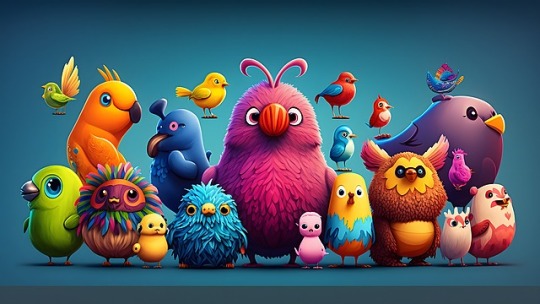
Feel free to customize the content based on the specific features, curriculum, and goals of the 3D animation course offered by Pickles Animation!
0 notes
Text
Who are the Best Residential and Home Interior Designers in Pune?
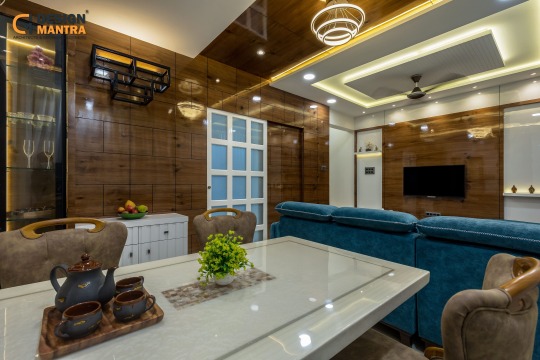
https://designmantrastudio.com/who-are-the-best-residential-and-home-interior-designers-in-pune.html
Design Mantra is one of the Best Residential interiors designing company in Pune for the past 13 years. Design Mantra Interiors provide the services in Pune. Design Mantra having the best modular kitchen designing experience with preview 3D kitchen interior design that fulfils all your needs. 100% Customized Home Interiors in Pune from best Interior designers in Pune.
Get Free Estimate from Interior Designers in Pune for Homes, Apartments and Flats
Transform your kitchen to the heart of your home with the help of Home Lane. From coffee dates to dinner parties, our end-to-end design and installation services will turn your kitchen into a stylish and functional space. Design Mantra is one of the Best Home interiors designing company in Pune and they having best designing experience. A Kitchen should be a peaceful and restful retreat. The color scheme should be calming and soothing, with soft, neutral tones that create a sense of tranquility. The furniture should be comfortable and functional, with a bed as the focal point of the room.
Wardrobes are furniture pieces that help store and organize clothing and other personal belongings which makes them an essential part of any bedroom design. Wardrobe designs can range from simple, single-door units to large, multi-door armoires and can be made of a variety of materials like wood, metal or plastic and they can be crafted in a range of decor styles. Let’s make your bedrooms as functional as they’re aesthetic, shall we? Space-saving furniture is designed to be compact and take up as little space as possible. It is well suited for small apartments, homes and offices where space is at a premium. This kind of furniture which includes Murphy beds, fold-down tables and convertible sofas can be easily stowed away when not in use and can help maximize the use of the available space in a room.
What is Design mantra? What services do you offer? Why should I choose Design mantra?
Design mantra is a full-service professional interior design firm, Pune led by dynamic architects and interior designers focused on making designer homes personalized to your tastes and needs available within your budget. We aim to bring premium design and quality to each and every home buyer.
Our services include interior designing Pune, custom furniture, false ceiling, flooring, wall accents, and so much more. We deliver high-quality interiors because we have a 100% in-house team, whose work we strictly monitor based on the quality checklist. And that’s why we can even give you a full home warranty!
Do you charge a design fee?
No, Design services are free of cost for Rooms that are part of the order.
How is the pricing calculated?
Each home has its own needs and requirements based on its size, its design, material finish and hardware used as well storage options. The prices are generated dynamically from our software based on your custom design, giving you full flexibility to create designer homes.
#Interior Designer in Magarpatta#Interior Designer in Pimple Saudagar#Interior Designer in Bavdhan#Interior Designers in Aundh#Interior Designer in Wakad#Interior Designers in Hinjewadi#Interior Designer in Ravet#Interior Designer in Baner#Interior Designer in Viman Nagar#Interior Designer in Pimpri Chinchwad
0 notes
Text
Digital Media: Sources & Significance
Reader
1. H. Desamsetti & K. Lal (2019) , “Being a Realistic Master: Creating Props & Environments Design for AAA Games, Asian Journal of Applied Linguistics, Vol. 6 No.2”,
The authors covers the procedure and workflows for creating virtual reality, environments, and assets for AAA video games. This defines that an environment designer is responsible for visually creating a game world and works with teams of concept art, animation, level design, tech art and so on. An important approach is to create modular assets have a rigid grid that can be easily integrated with larger environments such as building materials. In property creation, referencing has a significant role, with 3D scanning of the base model, collecting reference images and many other ways. Other tips authors given include the importance of setting up the right metrics quickly, reusing the modular pieces, playtesting for a smooth gameplay flow and so on. In overall, the article helped me to understand what are the duties of an environment & props artist in creating a game.
2. J. Roettl & R. Terlutter (2018), “The same video game in 2D, 3D or virtual reality – How does technology impact game evaluation and brand placements?” https://doi.org/10.1371/journal.pone.0200724
This article helps to examine the influence of player experience and brand placement on playing the same video game in 2D, 3D and head-mounted-display (HMD) virtual reality (VR) versions. The authors have helped us to understand the limitations & implications. They shows that while HMD VR increases the perception of presence, it can lead to drawbacks such as lower brand recall and increased cognitive load, which can affect the overall gaming experience. Such information from these findings contribute valuable insights into the growing field of participatory games and virtual reality. The data examines the effects of different video game technologies(2D, 3D and VR) on player experiences, including presence, motivation, perception of the game, and memory of brand placements in the game.
3. H. MCQuillan (2020), “Digital 3D design as a tool for augmenting zero-waste fashion design practice, International Journal Of Fashion Design, Technology And Education”,
The article discusses the use of 3D design software as a way to enhance low-waste fashion design. Zero-waste fashion aims to eliminate farbric waste from clothing production through pattern making. The author discusses their design process before and after learning 3D software. The overall article explores examples from industry, academia and research on ‘the use of 3D software’ for ‘zero-waste design’. Benefits include faster identification of design ideas, remote collaboration, more accurate digital prototypes instead of physical prototypes, and test design pushes before physical prototypes. The software changes the business process further, it finds relationship between form, model and waste. This helps manage costume waste during design. The authors proposes a new waste-free 3D software. It concludes that 3D tools provide a unique enhancement to waste-design by design by providing simultaneous visibility into fabric use and appearance. This allows for creative freedom while reducing waste, moving fashion towards sustainability.
4. D. Livingstone, J. Kemp & E. Edgar (2016), “From Multi-User Virtual Environment to 3D Virtual Learning Environment, ALT-J, Research in Learning Technology”” https://www.tandfonline.com/doi/epdf/10.1080/09687760802526707?needAccess=true
The paper discusses the development of sloodle, an integrated system combining the Second Life ‘multi-user virtual environment’ (VLE). It reviews the history of using online virtual worlds for education, and argues that while such environments are good for synchronous collaboration and experiential learning, they lack features common in VLEs like Moodle for supporting asynchronous activities, course management, and assessment. Sloodle aims to bridge this gap by integrating Second Life and Moodle, allowing features like chat, blogs, assignments, and content distribution to work across both platforms. The development of Sloodle has been community-driven, informed by surveys, feedback, and a pilot study. Early results show it being used effectively for things like reflective discussion, connecting remote student groups, and motivating learners. The paper concludes that tightly integrating immersive 3D environments like Second Life with web-based learning platforms can create a true 3D virtual learning environment with expanded capabilities of benefit teaching and learning.
5. S. Van Nguyen, S. Thanh Le, M. Khai Tran & H. Manh Tran (2021), “Reconstruction of 3D digital heritage objects for VR and AR applications, Journal of Information and Telecommunication” https://doi.org/10.1080/24751839.2021.2008133
The article presents a method for reconstructing 3D digital heritage objects for use in virtual reality (VR) and augmented reality (AR) applications. The method involves: 1) Collecting data on real objects using a 3D scanner which outputs 3D point clouds. 2) Processing the data to remove noise and triangulate the object surface, detecting holes represented by boundary points and triangles. 3) Reconstructing the object by filling holes on the triangular surface. The novel approach focuses on preserving the local shape of the surface when filling holes. 4) Building VR and AR applications to visualize a virtual museum with reconstructed heritage objects. Results demonstrate the new hole-filling approach better reconstructs surface details compared to existing methods. The method aims to support cultural heritage conservation and research by accurately recreating damaged or missing tangible artifacts.
6. A. Chia (2022), “The Metaverse, but not the way you think: game engines and automation beyond game development, Critical Studies in Media Communication”, https://doi.org/10.1080/15295036.2022.2080850
In this article, the authors explains how game engines like Unity and Unreal Engine are being positioned by tech companies as the infrastructure for building interconnected virtual worlds known as the “metaverse”. Game engines provide the real-time 3D rendering and physics simulations that allow users to interact with digital environments. Beyond gaming, engines are increasingly adopted in industries like film, architecture, and manufacturing for interactive visualization and simulation. As engines expand beyond gaming to render people and objects in other industries, the implications go beyond labor displacement. The cultural assumptions and values that shape automation decisions in game development migrate to other contexts like architecture and manufacturing. The article calls for game studies to follow the influence of engines across industries in order to shape their emerging role as infrastructure for cultural production ande material processing.
7. Y. B. Kafai & Q. Burke (2016), “Constructionist Gaming: Understanding the benefits of making Games for Learning” https://doi.org/10.1080/00461520.2015.1124022
The article talks about architectural games, especially in game design, offer a multi-dimensional approach to learning. The individual component emphasizes the application and transfromation of knowledge through the program and academic interventions. The social dimension emphasizes collective planning and sharing or exchanging plans in the community. The cultural dimension examines the benefits and limitations of participation, focusing on diversity, cultural context, empowerment, collaboration, and critical communication. Together these dimensions contribute to understanding all have the educational potential of game planning in serious sports. In overall, the article highlights on several key findings an insights related to the use of game theory activities as an environment for teaching computational theory and practice, with a focus on strategic and constructivist perspectives. The vision of “connected play” is based on an inclusive approach where students can not only play but also create the games they want to see and play, and encourages an environment conductive to learning.
8. S. Safikhani, S. Keller, G. Schweiger & J. Pirker, “Immersive virtual reality for extending the potential of building information modeling in architecture, engineering and construction sector: systematic review, International Journal of Digital Earth”, https://doi.org/10.1080/17538947.2022.2038291
The article focuses on the integration of virtual reality (VR) with ‘Building Information Modeling (BIM)’ in the architecture, engineering and construction (AEC) industry. There is a growing need for digital transformation in AEC, and the paper suggests that VR applications using consumer-based head-mounted displays (HMDs) could be a solution and the BIM is recognized as a promising technology in the AEC sector. The article helps us to understand the role of VR in overcoming BIM challenges, which is to bridge the gap in connectivity and integration, VR is also being used. The paper argues that VR can provide new capabilities for BIM that previously did not exist or were difficult to implement. The objectives of the article is to systematically review recent research on the use of VR in BIM.
9. D. Abbott, “ Game-based learning for postgraduates: an empirical study of an educational game to teach research skills, Higher Education Pedagogies”, https://doi.org/10.1080/23752696.2019.1629825
This paper describes the development and evaluation of the “How to play your research Degree” educational game. The paper focuses on game-based learning (GBL) in secondary education, in particular the teaching of postgraduate research. The article gives an introduction to educational games, which is also known as serious games, and are recognized as effective tools for learning occurs through games and associated learning practices. In the context of differences in GBL’s use of higher education, secondary schools have been slower to adopt game-based learning compared to school-based interventions due to specific barriers. The data analyzes the gameplay loops in detail to show the relationship between different game mechanics and their associated learning processes. The overall aim of the article was to address two distinct perspectives in GBL in extracurricular settings which helps in effective teaching of high-level functional learning outcomes through interactive games and factors and it yields an understanding of the students involved in the process.
10. G. McElwee, R. Smith & P. Somerville, “Conceptualizing animation in rural communities: the village SOS case, Entrepreneurship & Regional Development”, https://doi.org/10.1080/08985626.2017.1401122
This is a study that introduces and explores the concept of “animatorship” in the context of rural development and entrepreneurship. Often, researchers focus on the “entrepreneurial hero” as a key driver of rural employment and growth. The paper introduces the concept of “community entrepreneurship” that goes beyond individual definitions to include collaborative efforts in business development at the local level. The main objective is to demonstrate the potential of animatorship as a catalyst for rural community entrepreneurship and animation practices. The paper is first structured to introduce and explore the concept of animatorship, followed by a literature review, a discussion of animatorship in the village SOS system, the methodology information, presentation results, and finally conclusions and recommendations. From this article we can conclude that animatorship is a valuable and previously neglected concept that contributes to understanding how entrepreneurial activities contribute to rural development.
0 notes
Text
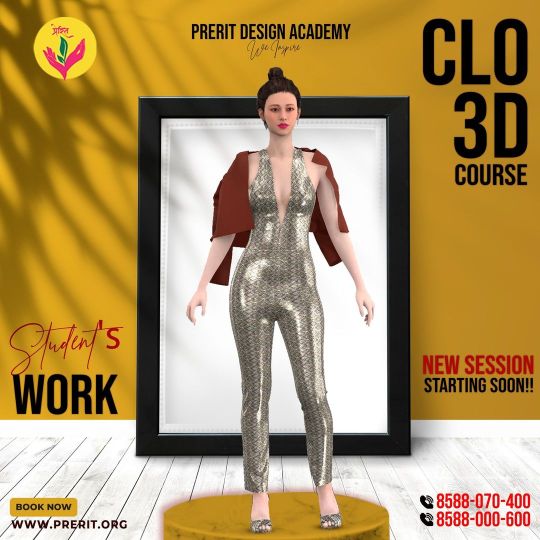
Clo 3D design has developed into a highly sought-after skill due to the expanding demand for more efficiency and a reduced environmental impact within the fashion sector.
#Clo#CLO 3D#CLO 3D Software#Fashion design software#3D Dress design#Clothing Design Software#3D Cloth#Cloth 3D Model#3D Designer#3d clothing design software free
2 notes
·
View notes
Text
Strong Statements: Mastering the Artwork of Style Phrase
In a world wherever style is definitely an ever-changing tapestry of creativity and self-expression, the realm of style stands as a testament to the vibrant character of human ingenuity. Style transcends pure clothing; it is a visual language, a representation of societal changes, and a fabric upon which persons paint their identities.
The Development of Style: A Traditional Journey
The annals of fashion is just a interesting plot, weaving together cultural impacts, technological advancements, and the ebb and movement of societal values. From the structured silhouettes of the Victorian time to the free-spirited bohemian varieties of the 1960s, each period has remaining an indelible level on the style landscape. Nowadays, the style market is just a melting container of impacts, with designers pulling enthusiasm from the past while forcing the limits of innovation.
Developments That Transcend Time
While styles will come and get, certain aspects of fashion stay timeless. The appeal of a properly designed match, the grace of a streaming outfit, and the assurance exuded by way of a well-curated road design set are components that endure the check of time. In this fast-paced world, where traits can transform in the blink of an eye, these enduring classics give a stable basis for personal style.
The Runway as a Playground of Creativity
Style months about the planet offer as the great point where designers showcase their newest creations. The runway becomes a theater of innovation, wherever textiles, colors, and finishes are stitched together to create a symphony of style. It is here now that fashion becomes art, forcing boundaries and tough preconceived notions of what apparel can be. Makers not merely provide clothes but narratives that speak to the zeitgeist.
Fashion and Identity: A Particular Expression
In some sort of teeming with diverse cultures and perspectives, fashion becomes a powerful software for persons to talk their identities. From subcultures that escape societal norms to the combination of worldwide impacts in one single ensemble, fashion allows for a nuanced exploration of self-expression. The choices we make in clothing aren't nearly covering our bodies; they are about showing our reports to the world.
Sustainability in Design: A Natural Innovation
As the style industry grapples using its environmental affect, a new trend of sustainable practices is reshaping the landscape. From eco-friendly components to rounded fashion initiatives, developers and customers alike are adopting a more thorough approach. The thought of "gradual fashion" gains energy, encouraging aware consumption and a departure from the throwaway tradition that's identified a for decades. Women's Fashion
The Potential of Style: A Canvas of Possibilities
As we stay at the intersection of tradition and creativity, the continuing future of fashion is a material of endless possibilities. Technological developments like 3D printing, enhanced truth, and sustainable fabric improvements are shaping a fresh time of fashion. The democratization of type through social media marketing and on the web programs enables diverse sounds to be seen, difficult the standard gatekeepers of the industry.
In conclusion, fashion is really a tapestry woven with strings of creativity, culture, and identity. It is definitely an ever-evolving art kind that shows the nature of the changing times while giving a program for individual expression. Even as we navigate the fascinating journey through the world of style, something remains certain: the beauty of type may remain expanded, offering a perpetual source of inspiration for decades to come.
0 notes
Text
Increase User Interaction with AR/VR Development
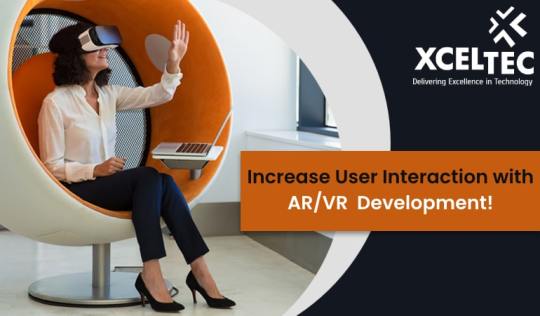
AR and VR have become revolutionary technologies in a digital world that continues to evolve to provide richer and more captivating experiences. These immersive technologies offer businesses creative ways to boost user interaction in addition to captivating users. We'll go over the main tactics and advantages of using AR/VR development to improve user engagement in a variety of sectors.
1. Creating a Seamless Blend of Real and Virtual Worlds:
In a digital world in which experiences are getting richer and more fascinating by the second, AR and VR have emerged as revolutionary technologies. Not only can these immersive technologies captivate people, but they also give businesses innovative opportunities to increase user involvement. In this article, we'll discuss the key strategies and benefits of leveraging AR/VR development to raise user engagement across media platforms.
2. Interactive Product Visualization:
ZProduct visualization is one of AR/VR's best applications. These technologies can be used by businesses to let customers engage virtually with things before they decide to buy them. AR/VR improves the user's comprehension and relationship with the product when it comes to discovering the features of a complicated machine, arranging furniture in a room, and trying on virtual clothes.
3. Gamification for Enhanced Engagement:
A dynamic platform for personalization is offered by AR development, which turns user interactions into engaging and entertaining experiences. Businesses may boost user engagement, promote involvement, and establish memorable interactions by including gaming components. Marketing campaigns, instructional software, and training simulations all benefit greatly from this strategy.
4. Training and Skill Development:
Development of AR/VR allows authentic instructional simulations in a variety of areas, including manufacturing and healthcare. In a risk-free virtual setting, users may test their abilities through practical training scenarios. This makes learning more enjoyable and guarantees that users are more equipped to handle problems in the actual world.
5. Personalized and Interactive Learning:
AR and VR technology are changing education by providing individualized and interactive learning opportunities. With the use of these technologies, students can travel to far-off locations, examine historical events, and dissect virtual species all from the comfort of their classroom. A more interesting and successful learning process is the end outcome.
6. Enhancing Virtual Meetings and Collaboration:
In the era of remote work, AR/VR development is transforming virtual meetings and collaboration. By creating virtual meeting spaces and interactive 3D models, users can collaborate in a more immersive and engaging manner. This not only enhances communication but also fosters a sense of presence and connection among team members.
In conclusion, companies looking to boost user engagement should consider integrating AR and VR development into their operations. Through immersive learning experiences, product visualization, or gamification, these technologies have the ability to completely change the way people interact with products and content. To develop a scalable and efficient AR/VR-based application that has the potential to compete within the market, it must be developed by innovative brains. Here at Xceltec, we've got a passionate team of Hire AR/VR developers and technology specialists. Designers, UI/UX experts, modelers, and programmers.
0 notes
Text
Polygons Effect - Projection Mapping Loops Pack Vol.12
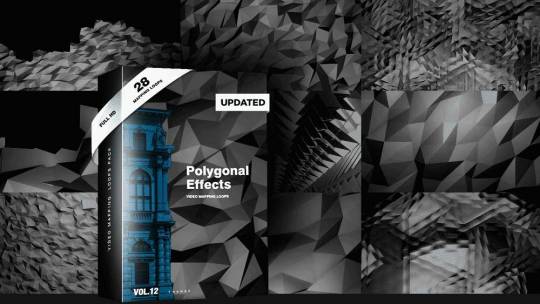
Download for Projection 3D Mapping Performances.
Download exclusive visuals for projection 3D Video Mapping Show! Exclusive 30 monochromatic video mapping loops produced with polygonal effect style. Low-poly 3D displace motion backgrounds for projection mapping show. Video Mapping Loops Pack is an original video art digital content produced in resolution and frame rate. Video Mapping 3D Effects Visuals is compatible with different Vj software products and Video Projection Media Servers. Original Video Mapping Loops Pack produced in higher resolution and frame rate. was developed especially for VJ’s, Digital Visual Artists and Motion Designers. You can use for Architectural or interior Video Mapping performances and for Fulldome Video Projection Show. Video Mapping Loops was encoded in video format. Create Video Mapping 90% faster without plugins or scripts - Use 3D Effect Video Footage for Your Video Projection Show. Compatible with all VJ and Video Mapping Software
Royalty Free resolution video mapping content. Looped videos & Motion Backgrounds for Video Projection Show
After purchase You will get a confirmation Email with PDF invoice and links for digital instant download. If You will have any questions regarding your order You could reach us via Email or Mobile, WhatsApp, Telegram or Viber by +43 676 391 10 49. Also by online chat webform our Support Manager could help You!
100% temptation. Immediate and pleasurable urge to make any surface made of fabric induces to purchase Cloth Facade. 3D Simulation of Cloth Animation special for Facade Architectural video projection mapping. Loose the ties of self-control. Positive consequences guaranteed. 1920X1080 Full HD Video Resolution / 29 fps (29 frames per second) / Quicktime Photojpeg video encoding / All Clips are looped.
Read the full article
0 notes
Text
AI-driven tool makes it easy to personalize 3D-printable models
With Style2Fab, makers can rapidly customize models of 3D-printable objects, such as assistive devices, without hampering their functionality.
Adam Zewe | MIT News

As 3D printers have become cheaper and more widely accessible, a rapidly growing community of novice makers are fabricating their own objects. To do this, many of these amateur artisans access free, open-source repositories of user-generated 3D models that they download and fabricate on their 3D printer.
But adding custom design elements to these models poses a steep challenge for many makers, since it requires the use of complex and expensive computer-aided design (CAD) software, and is especially difficult if the original representation of the model is not available online. Plus, even if a user is able to add personalized elements to an object, ensuring those customizations don’t hurt the object’s functionality requires an additional level of domain expertise that many novice makers lack.
To help makers overcome these challenges, MIT researchers developed a generative-AI-driven tool that enables the user to add custom design elements to 3D models without compromising the functionality of the fabricated objects. A designer could utilize this tool, called Style2Fab, to personalize 3D models of objects using only natural language prompts to describe their desired design. The user could then fabricate the objects with a 3D printer.
“For someone with less experience, the essential problem they faced has been: Now that they have downloaded a model, as soon as they want to make any changes to it, they are at a loss and don’t know what to do. Style2Fab would make it very easy to stylize and print a 3D model, but also experiment and learn while doing it,” says Faraz Faruqi, a computer science graduate student and lead author of a paper introducing Style2Fab.
Style2Fab is driven by deep-learning algorithms that automatically partition the model into aesthetic and functional segments, streamlining the design process.
In addition to empowering novice designers and making 3D printing more accessible, Style2Fab could also be utilized in the emerging area of medical making. Research has shown that considering both the aesthetic and functional features of an assistive device increases the likelihood a patient will use it, but clinicians and patients may not have the expertise to personalize 3D-printable models.
With Style2Fab, a user could customize the appearance of a thumb splint so it blends in with her clothing without altering the functionality of the medical device, for instance. Providing a user-friendly tool for the growing area of DIY assistive technology was a major motivation for this work, adds Faruqi.
He wrote the paper with his advisor, co-senior author Stefanie Mueller, an associate professor in the MIT departments of Electrical Engineering and Computer Science and Mechanical Engineering, and a member of the Computer Science and Artificial Intelligence Laboratory (CSAIL) who leads the HCI Engineering Group; co-senior author Megan Hofmann, assistant professor at the Khoury College of Computer Sciences at Northeastern University; as well as other members and former members of the group. The research will be presented at the ACM Symposium on User Interface Software and Technology.
Keep reading.
Make sure to follow us on Tumblr!
#research#3d printing#artificial intelligence#design#mechanical engineering#makers#assistive technology
0 notes